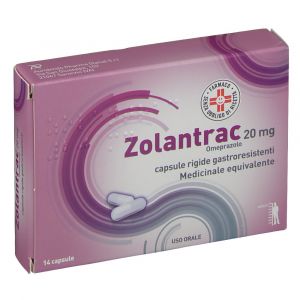Ship in Europe, Find out rates!

Zolantrac 20 mg Omeprazole 14 Gastro-resistant Capsules
AUROBINDO PHARMA ITALIA
Therapeutic indications
Zolantrac capsules are indicated for the treatment of reflux symptoms (e.g. heartburn, acid regurgitation) in adults.
Dosage
Posology in adults The recommended dose is 20 mg once daily for 14 days. It may be necessary to take the capsules for 2-3 consecutive days to improve symptoms. Most patients have complete resolution of heartburn within 7 days. Once complete resolution of symptoms has been achieved, treatment should be stopped. Special populations Impaired renal function Dosage adjustment is not required in patients with impaired renal function (see section 5.2). Hepatic impairment In patients with hepatic impairment, Zolantrac should be taken under medical advice (see section 5.2). Elderly (> 65 years) No dosage adjustment is required in elderly patients (see section 5.2). Method of administration It is recommended to take the Zolantrac capsules in the morning, preferably on an empty stomach, swallowed whole with half a glass of water. The capsules should not be chewed or crushed. For patients with swallowing difficulties Patients can open the capsule and swallow the contents with half a glass of water, or mixed with slightly acidic liquids such as fruit juice or apple puree or still water. Patients should be advised that in such cases the dispersion should be swallowed immediately (or within 30 minutes) and that it should always be mixed just before drinking. Rinse the bottom with half a glass of water and drink the contents. Alternatively, patients can dissolve the capsule in the mouth and swallow the contained granules with half a glass of water. The gastro-resistant granules must not be chewed.
Overdose
There is limited information available regarding overdose with omeprazole in humans. Doses up to 560 mg are reported in the literature and there have been occasional reports of single oral doses up to 2400 mg of omeprazole (120 times the usually recommended clinical dose). Nausea, vomiting, dizziness, abdominal pain, diarrhea and headache have been reported. In individual cases, apathy, depression and confusion have also been observed. The symptoms described were transient and no serious consequences were reported. With increasing doses the elimination rate did not change (first order kinetics). Treatment, if necessary, is symptomatic.
Contraindications
Hypersensitivity to the active substance, to benzimidazole substitutes or to any of the excipients listed in section 6.1. Omeprazole, like other proton pump inhibitors (PPIs), should not be administered concomitantly with nelfinavir (see section 4.5).
Side effects
The most common side effects (1–10% of patients) are headache, abdominal pain, constipation, diarrhea, flatulence, nausea / vomiting. The following adverse reactions, identified or suspected, have been identified during clinical trials with omeprazole and post-marketing. In no case was a correlation with the administered drug dose established. Undesirable effects are classified according to frequency and Organ Classification System (SOC). Frequency categories are defined using the following convention: Very common (≥1 / 10), Common (≥1 / 100 to <1/10), Uncommon (≥1 / 1,000 to <1/100), Rare (≥1 / 10,000 to <1 / 1,000), Very rare (<1 / 10,000), Not known (cannot be estimated from the available data).
| System organ class / frequency | Side effects | |
| Disorders of the blood and lymphatic system | ||
| Rare: | Leukopenia, thrombocytopenia | |
| Very rare: | Agranulocytosis, pancytopenia | |
| Disorders of the immune system | ||
| Rare: | Hypersensitivity reactions, e.g., fever, angioedema and anaphylactic reaction / shock | |
| Metabolism and nutrition disorders | ||
| Rare: | Hyponatremia | |
| Very rare | Hypomagnesemia | |
| Psychiatric disorders | ||
| Uncommon: | Insomnia | |
| Rare: | Agitation, confusion, depression | |
| Very rare: | Aggression, hallucinations | |
| Nervous system disorders | ||
| Common: | Headache | |
| Uncommon: | Dizziness, paraesthesia, somnolence | |
| Rare: | Changes in taste | |
| Eye disorders | ||
| Rare: | Blurred vision | |
| Ear and labyrinth disorders | ||
| Uncommon: | Dizziness | |
| Respiratory, thoracic and mediastinal disorders | ||
| Rare: | Bronchospasm | |
| Gastrointestinal disorders | ||
| Common: | Abdominal pain, constipation, diarrhea, flatulence, nausea / vomiting | |
| Rare: | Dry mouth, stomatitis, gastrointestinal candidiasis, microscopic colitis | |
| Hepatobiliary disorders | ||
| Uncommon: | Elevation of liver enzyme values | |
| Rare: | Hepatitis with or without jaundice | |
| Very rare: | Hepatic failure, encephalopathy in patients with pre-existing liver disease | |
| Skin and subcutaneous tissue disorders | ||
| Uncommon: | Dermatitis, itching, rash, hives | |
| Rare: | Alopecia, photosensitization | |
| Very rare: | Erythema multiforme, Stevens-Johnson syndrome, toxic epidermal necrolysis (TEN) | |
| Not known: | Subacute cutaneous lupus erythematosus (see section 4.4) | |
| Musculoskeletal and connective tissue disorders | ||
| Rare: | Arthralgia, myalgia | |
| Very rare: | Muscle weakness | |
| Renal and urinary disorders | ||
| Rare: | Interstitial nephritis | |
| Reproductive system and breast disorders | ||
| Very rare: | Gynecomastia | |
| General disorders and administration site conditions | ||
| Uncommon: | Malaise, peripheral edema | |
| Rare: | Increased sweating | |
| Diagnostic tests | ||
| Not known: | Abnormal urea breath test (see section 4.4 Special warnings and precautions for use). | |
Pregnancy and breastfeeding
Pregnancy The results of three prospective epidemiological studies (more than 1000 exposed patient outcomes) indicate no adverse effects of omeprazole on pregnancy or on the health of the fetus / newborn. Omeprazole can be used during pregnancy. Breastfeeding Omeprazole is excreted in breast milk but is unlikely to affect the infant when administered in therapeutic doses.
Special warnings
In the presence of certain alarm symptoms (e.g. significant unintended weight loss, recurrent vomiting, dysphagia, haematemesis or melaena) and when gastric ulcer is suspected or present, the malignant nature of the ulcer must be excluded as symptomatic response to therapy may delay a correct diagnosis. Co-administration of atazanavir and proton pump inhibitors is not recommended (see section 4.5). If the combination of atazanavir and proton pump inhibitor is judged unavoidable, careful clinical monitoring (eg viral load) is recommended in combination with an increase in the dose of atazanavir to 400 mg with 100 mg of ritonavir; the dose of omeprazole should not exceed 20 mg. Omeprazole, like all acid-suppressive medicines, can reduce the absorption of vitamin B 12 (cyanocobalamin) due to hypo- or achlorhydria. This should be taken into consideration in patients with low reserves or risk factors for reduced vitamin B 12 absorption in case of long-term therapy. Omeprazole is a CYP2C19 inhibitor. Potential interaction with drugs metabolised by CYP2C19 should be considered at the start or end of omeprazole treatment. An interaction between clopidogrel and omeprazole has been observed (see section 4.5). The clinical relevance of this interaction is uncertain. As a precaution, concomitant use of clopidogrel and omeprazole should be discouraged. Treatment with proton pump inhibitors may cause a slightly increased risk of Salmonella and Campylobacter gastrointestinal infections (see section 5.1). Patients with long-term recurring symptoms of dyspepsia or heartburn should see their doctor at regular intervals. In particular, patients over the age of 55 who are taking daily over-the-counter (OTC, non-prescription medicines) for dyspepsia or heartburn should inform their pharmacist or doctor. Patients should be advised to consult a physician if: • They have had a previous gastric ulcer or have undergone gastro-intestinal surgery • Are on continuous symptomatic treatment for dyspepsia or heartburn for 4 or more weeks • Have jaundice or are suffering from severe liver disease • Are over the age of 55 and their symptoms are new or have recently changed. Patients should not take omeprazole as a preventative treatment. The intake of proton pump inhibitors can cause alteration of the results of the urea breath test for the detection of Helycobacter pylori . Therefore, the administration of omeprazole must be stopped 2 weeks before the test. Subacute cutaneous lupus erythematosus (SCLE) Proton pump inhibitors are associated with extremely infrequent cases of SCLE. In the presence of lesions, especially on the skin parts exposed to sunlight, and if accompanied by arthralgia, the patient should immediately seek medical attention and the healthcare professional should consider stopping treatment with Zolantrac. SCLE following treatment with a proton pump inhibitor may increase the risk of SCLE with other proton pump inhibitors. Interference with laboratory tests An increased level of Chromogranin A (CgA) may interfere with diagnostic tests for endocrine tumors.To avoid this interference, Zolantrac treatment should be stopped for at least 5 days before CgA measurements (see section 5.1) . If the CgA and gastrin levels have not returned to the reference range after the initial measurement, measurements should be repeated 14 days after stopping the proton pump inhibitor treatment.
Expiry and Retention
Do not store above 30 ° C. Store in the original package in order to protect from moisture.
Active principles
Each capsule contains 20 mg of omeprazole. For a full list of excipients, see section 6.1.
Excipients
Microcrystalline cellulose, low-substituted hydroxypropylcellulose, mannitol, croscarmellose sodium, polysorbate 80, povidone K-30, arginine, sodium lauryl sulfate, glycine, light magnesium carbonate, hypromellose, methacrylic acid-ethylacrylate copolymer, triethyl citrate, sodium hydroxide, triethyl citrate , gelatin, indigo carmine (E-132), titanium dioxide, water.
| Destination | Cost | Detail |
|---|---|---|
| Italy | €5,90* | 24/72H |
| Austria, France, Germany, Slovenia | € 13* | 3 days |
| Belgium, Luxembourg, Portugal, Netherlands, Spain | € 14* | 4 days |
| Bulgary, Cechia, Hungary, Poland, Romania, Slovakia | € 19* | 5 days |
| Denmark, Estonia, Finland, Ireland, Lithuania, Latvia ,Sweden | € 22* | 5 days |
| United Kingdom, Switzerland, Greece | € 30* | 7 days |
| Canada, USA | € 40 | 7 Days |
European shipments with express courier: FedEx, MBE, DHL
*For the shipment outside band B ther's an extra cost of 22€ *For the shipment outside band C ther's an extra cost of 30€ Delivery Times exclude Saturday and Holidays
For Islands and Areas of difficult Accessibility the shipments are made in 72 hours and the cost will be increased by 15€
